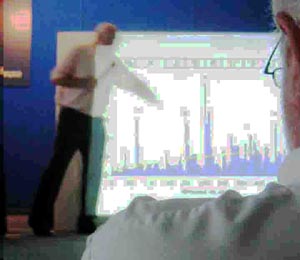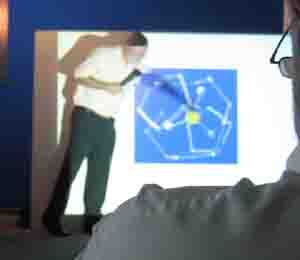Science
methane


Dr Rodolfo del Valle, Head of Earth Sciences, National Antarctic Direction, Argentina, speaking at the Sur Polar conference, Buenos Aires, March 2008
The Polar regions are thought to contain, in terms of methane hydrates, more than half of the total carbon in the entire planet - that is twice the biomass, the coal and fossil hydrocarbons (petrol, natural gas) together.
We are dealing with natural leaks of methane which we have spotted at the sea bottom in the NW region of the Weddell Sea. We are also monitoring the condition of marine sea ice in the same region. We have followed the formation process of the layer of frozen sea and its recess during August, September and October - which are the most significant months for the stretching of marine ice. Usually in Antarctica marine ice grows and stretches in those months until it reaches some 10 million square kilometers. In that period of maximum ice stretching we have observed its recess, that is to say, a reduction, a significant disintegration. This fact, added to the recess of the glaciers that we have measured to the extreme north of the Antarctic Peninsular shows us that the climate warming is having a strong impact in the region where we had thought to use the frozen sea ice as an "ice highway" for our shifting towards the zone of Isla Marimbio (Seymore Island). We were studying there the natural gas leaks from the sea bottom. We intended to reach the area we had detected with snow motorcycles, through the satellite navigation system GPS, the methane leaks...
The natural methan gas (CH4) leaks are a product of the rise of the sea level - something that took place due to climate warming - the one which produced the main thawing in the Antarctic after the last glaciation. This defrosting caused the sea level to rise some 100/120 meters, and this flooded some Antarctic areas which were precviously exposed to the atmosphere's severe cold during the glaciation. During the glacial perios, the deep freezing of the soil in those coastal strips exposed to low temperatures trapped methane coming from bacterial activity in the substratum thus producing a substance known as clathrate or methane hydrate - a composite of frozen ice moleucles (ice) which contains methan molecules in its crystalline network. The Polar regions are thought to contain, in terms of methane hydrates, more than half of the total carbon in the entire planet - that is twice the biomass, the coal and fossil hydrocarbons (petrol, natural gas) together...
We are additively interfering in the natural oscillation of the cycle of carbon; there's anthropic evidence, one produced by man; an interference which is positive, additive, and adds to the rise-fall oscillation. Through the increase of the greenhouse gas effect gases, we are causing the temperature to rise too much and just in the middle of a rising cycle - this might break the cycle. I believe this additive interference is already dangerous. Nature might be unable to restore the balance.
For this process we could make an analogy with the father who swings his child in a park hammock. He swings the kid cyclically, with a certain rhythm, not at random - otherwise, the hammock would twist, the child would fall...and the game would be over. I believe there's more and more evidence that we are "twisting the chain of the hammock".
Extracts from Additively interfering in the Natural Oscillation: Interview between Rudolfo del Valle and Andrea Juan on board the icebreaker ARA Almirante Irizar during the summer Antarctic campaign, February 2005. Catalogue, Andrew Juan: antarctic project, Buenos Aires 2006








